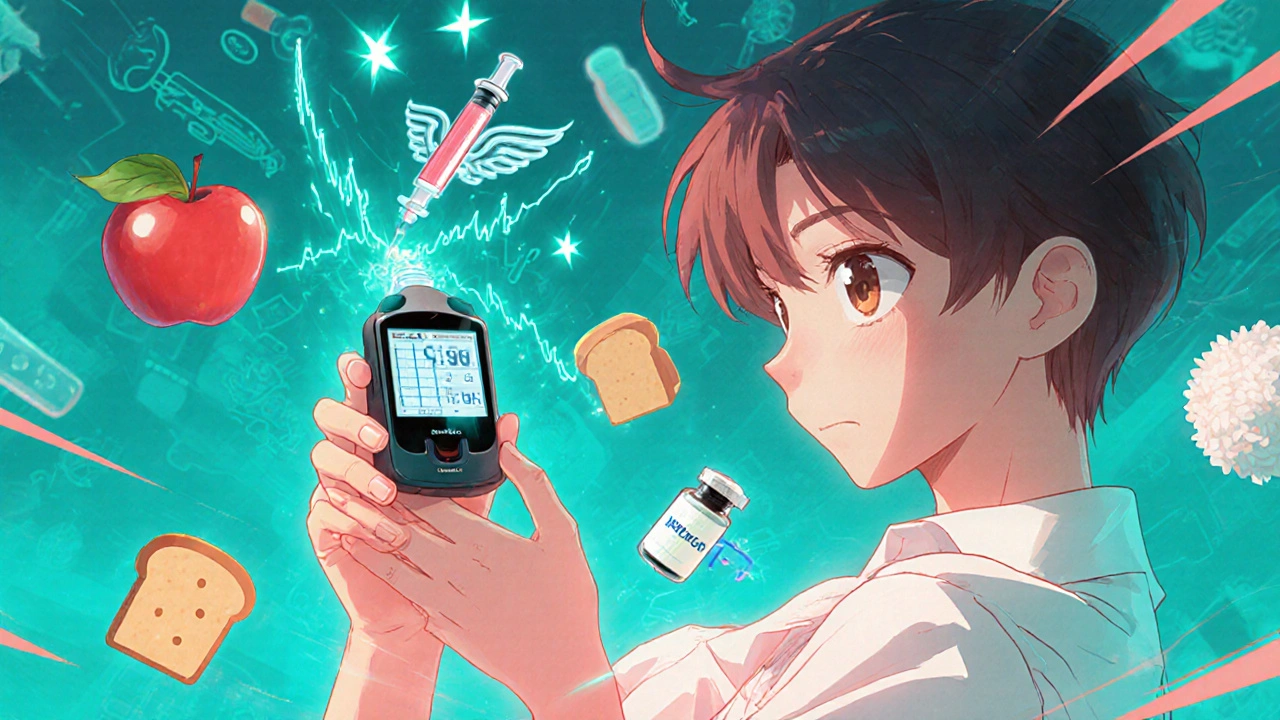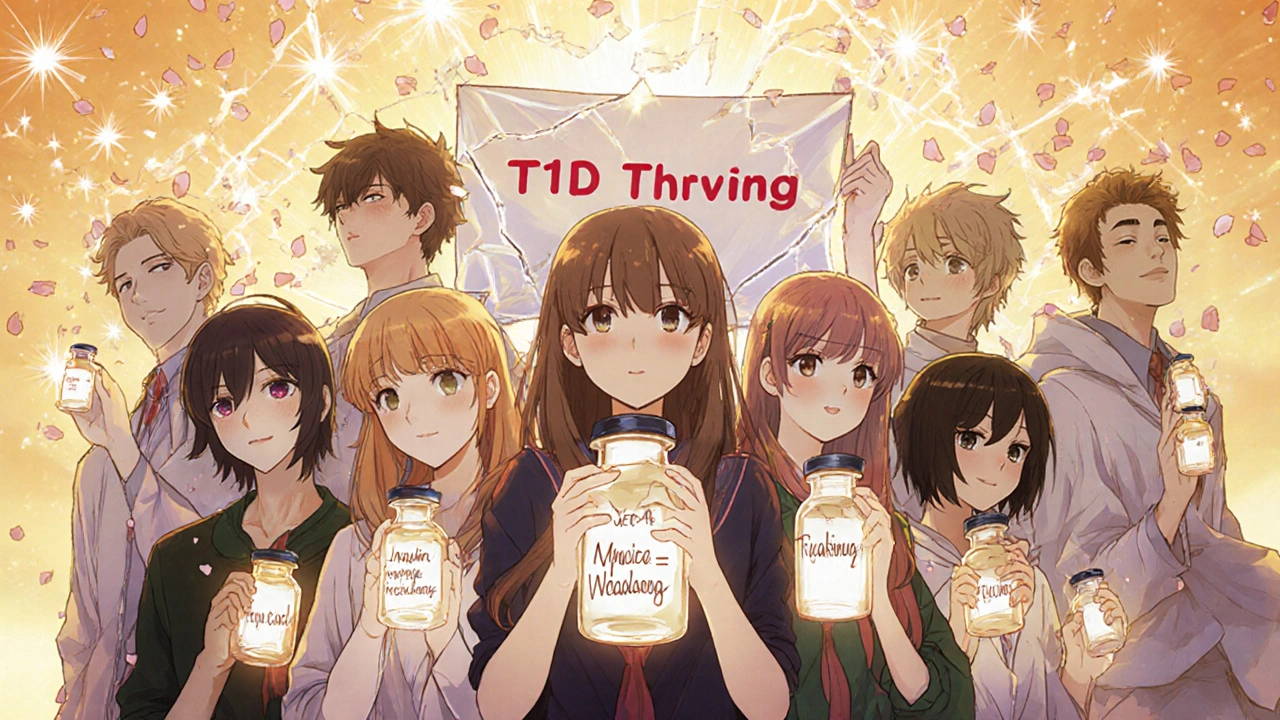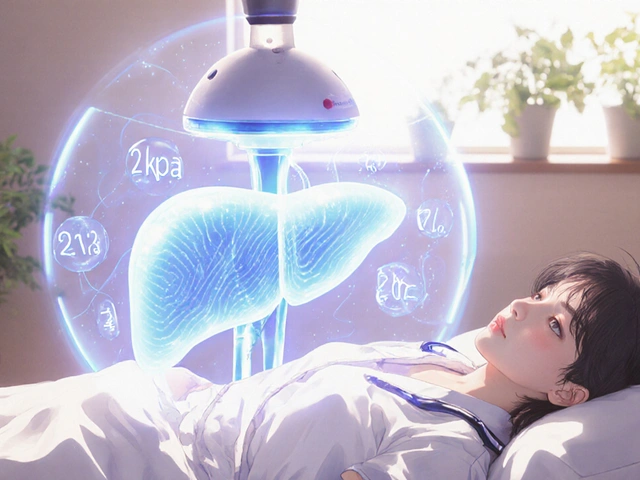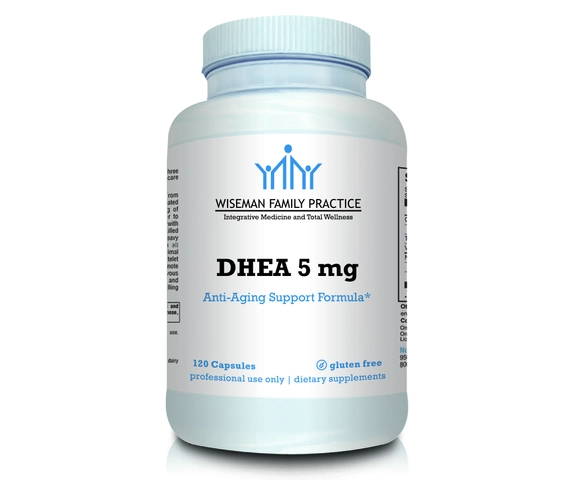When your body stops making insulin, life changes overnight. Type 1 diabetes isn’t caused by diet or laziness-it’s an autoimmune disease where your immune system attacks the insulin-producing cells in your pancreas. No one chooses this. No one causes it. But once diagnosed, managing it becomes your new normal. And while it’s serious, it’s not a death sentence. With the right tools and knowledge, people with type 1 diabetes live full, active lives. The key? Understanding the symptoms early, getting diagnosed correctly, and choosing the right insulin therapy.
What Are the Signs You Might Have Type 1 Diabetes?
The symptoms of type 1 diabetes don’t creep up slowly. They hit hard and fast. You might wake up needing to pee every hour. You’re thirsty all the time-even after drinking a full glass of water. You’re losing weight without trying, even though you’re eating more. Your energy is gone. You feel like you’re running on empty, no matter how much sleep you get. These aren’t just inconveniences. They’re warning signs your body is starving for fuel. Without insulin, glucose can’t enter your cells. So your body starts breaking down fat and muscle for energy. That’s why you lose weight. That’s why you’re constantly hungry. That’s why your urine is full of sugar-and why your breath smells fruity. Other common signs include blurry vision, dry mouth, slow-healing cuts, and frequent infections. In kids, bedwetting can suddenly reappear. In teens, it might look like a sudden drop in sports performance or mood swings. The CDC says symptoms can go from mild to life-threatening in under 24 hours. If you’re experiencing this combo-excessive thirst, frequent urination, unexplained weight loss-you need a blood test now.How Is Type 1 Diabetes Diagnosed?
There’s no single test that confirms type 1 diabetes. Doctors use a mix of blood tests to be sure. The most common is the A1C test. It shows your average blood sugar over the past 2-3 months. If your A1C is 6.5% or higher on two separate tests, you have diabetes. But A1C alone doesn’t tell you if it’s type 1 or type 2. That’s where autoantibody tests come in. If you have GAD65, IA2, or ZNT8 antibodies in your blood, your immune system is attacking your pancreas. That’s type 1. These tests are critical, especially in adults, because many are misdiagnosed with type 2 at first. Another key test is C-peptide. It measures how much insulin your body is still making. In type 1, C-peptide levels are low-even when blood sugar is sky-high. In type 2, they’re usually high because the body is still making insulin, just not using it well. Doctors also check for diabetic ketoacidosis (DKA), especially if symptoms came on suddenly. DKA happens when your body burns fat for fuel and produces toxic acids called ketones. Blood tests for pH, bicarbonate, and ketone levels can catch this early. Left untreated, DKA can lead to coma or death.Insulin Therapy: The Only Lifeline
There is no cure for type 1 diabetes. But there is treatment: insulin. You must replace what your body no longer makes. Without it, you die. That’s not an exaggeration. Insulin therapy isn’t optional-it’s survival. There are two main ways to deliver insulin: multiple daily injections (MDI) and insulin pumps. MDI, also called basal-bolus therapy, means taking two types of insulin every day. Long-acting insulin (like glargine or detemir) gives you background coverage-steady, all-day insulin. Then, before every meal, you take rapid-acting insulin (like lispro, aspart, or glulisine) to cover the carbs you eat. Most people take 3-5 shots a day. It’s precise, but it takes work. Insulin pumps are small devices worn on the body that deliver insulin through a tiny tube under the skin. They give you a continuous low dose (basal rate) and let you push a button to deliver extra insulin (bolus) at meals. Modern pumps connect to continuous glucose monitors (CGMs) and can even auto-adjust insulin based on your readings. These are called hybrid closed-loop systems. Brands like Medtronic’s MiniMed 780G and Tandem’s t:slim X2 with Control-IQ are now common. Studies show people using CGM-integrated pumps spend 70-75% of their time in the target blood sugar range-up from 50% with fingersticks alone. That means fewer highs, fewer lows, and less long-term damage.
What Are the Target Blood Sugar Levels?
Your goal isn’t to be perfect. It’s to stay as close to normal as possible. The American Diabetes Association recommends:- Before meals: 80-130 mg/dL
- Two hours after meals: under 180 mg/dL
- A1C under 7% for most adults
How Much Time Does Management Take?
Managing type 1 diabetes isn’t a part-time job. It’s full-time. People typically check their blood sugar 4-10 times a day. If you use a CGM, you’re still checking sensors every 7-14 days, calibrating them, and replacing the infusion set every 2-3 days. You also have to count carbs. Not guess. Count. If your insulin-to-carb ratio is 1:10, you need 1 unit of insulin for every 10 grams of carbs. That means knowing exactly how many carbs are in your oatmeal, your sandwich, your dessert. It’s not easy. Most people need 10-20 hours of training just to get started. And you have to watch for low blood sugar. Anything below 70 mg/dL is dangerous. You need to carry fast-acting sugar-glucose tablets, juice, candy-everywhere. You can’t drive, work, or exercise without knowing how to treat a low. The University of Michigan estimates people with type 1 diabetes spend 2-4 hours a day managing their condition. That’s a full workweek every month. No one talks about that part.What’s New in Type 1 Diabetes Treatment?
The last few years have brought real breakthroughs. In November 2022, the FDA approved teplizumab (Tzield). It’s not a cure. But it’s the first drug that can delay type 1 diabetes in people at high risk. Given as a 14-day IV infusion, it slowed progression by nearly two years in clinical trials. This is huge for kids with a family history of T1D. Stem cell therapy is also advancing. Vertex Pharmaceuticals’ VX-880 treatment replaces destroyed beta cells with lab-grown ones. In early trials, 89% of participants stopped needing insulin after 90 days. It’s still experimental, but it’s the closest thing to a cure we’ve seen. Insulin costs are still a crisis. The average person with type 1 diabetes spends over $20,000 a year on care. About $5,600 of that goes just to insulin. Even with insurance, many people ration insulin. That’s deadly.
What Comes After Diagnosis?
Getting diagnosed with type 1 diabetes feels like losing control. But it’s not the end. It’s the start of a new kind of strength. You’ll learn to read your body. You’ll understand how food, stress, sleep, and exercise affect your numbers. You’ll find a routine that works-for you. You’ll need a team: an endocrinologist, a diabetes educator, a dietitian. You’ll need support groups. You’ll need to talk to others who get it. You’re not alone. Over 1.6 million Americans live with type 1 diabetes. And they’re thriving. The tools are better than ever. The science is moving fast. The goal isn’t perfection. It’s balance. It’s freedom. It’s living well-despite the needles, the alarms, the constant calculations.Frequently Asked Questions
Can type 1 diabetes be reversed?
No, type 1 diabetes cannot be reversed. The immune system permanently destroys the insulin-producing beta cells in the pancreas. There is currently no cure. However, new treatments like teplizumab can delay onset in high-risk individuals, and stem cell therapies like VX-880 are showing promise in restoring insulin production. But even in cases where insulin independence is achieved, ongoing monitoring and potential immune suppression are still required.
Is type 1 diabetes the same as juvenile diabetes?
Yes, type 1 diabetes was once called juvenile diabetes because it often appears in children and teens. But it can develop at any age. About half of all new cases are diagnosed in adults. The term "juvenile diabetes" is outdated and misleading. Type 1 is an autoimmune condition, not just a childhood disease.
Can you outgrow type 1 diabetes?
No, you cannot outgrow type 1 diabetes. It is a lifelong condition. Even if blood sugar levels appear stable for long periods, the underlying autoimmune destruction of beta cells remains. Some people experience a "honeymoon phase" shortly after diagnosis, where the pancreas still produces a small amount of insulin. This can make management easier for months or even a year, but insulin will eventually be needed again.
Do people with type 1 diabetes need to avoid sugar completely?
No, people with type 1 diabetes do not need to avoid sugar completely. They can eat sweets and carbohydrates, but they must match them with the right amount of insulin. The key is accurate carb counting and insulin dosing. Many people use insulin pumps or CGMs to fine-tune their doses. Avoiding sugar entirely isn’t necessary-it’s just another food to plan for.
How often should A1C be checked?
The American Diabetes Association recommends checking A1C every 3 months if you’re not meeting your blood sugar goals or if your treatment plan has changed. If your diabetes is stable and you’re consistently hitting your targets, testing every 6 months is usually enough. A1C gives a 3-month average and helps your doctor see if your insulin doses, diet, or lifestyle need adjusting.
What’s the difference between type 1 and type 2 diabetes?
Type 1 diabetes is an autoimmune disease where the body destroys insulin-producing cells, leaving little to no insulin. Type 2 diabetes is mostly about insulin resistance-your body still makes insulin, but it doesn’t use it well. Type 1 usually starts suddenly, often in youth, and always requires insulin. Type 2 develops slowly, often in adults, and may be managed with diet, pills, or eventually insulin. Autoantibody and C-peptide tests can clearly distinguish between them.








Kathryn Ware November 18, 2025
Just wanted to say this post made me cry 😭 I was diagnosed at 12 and now I’m 34 - the pumps, the CGMs, the midnight lows… it’s a lot. But seeing someone finally explain the *real* daily grind - not just the medical jargon - means more than you know. I’ve been using a MiniMed 780G for 2 years now and my time-in-range went from 58% to 76%. It’s not perfect, but it’s freedom. And yes, I still count carbs like my life depends on it… because it does. 💪
kora ortiz November 20, 2025
You don't need to be perfect you just need to be consistent and the tools are better than ever stop letting fear stop you
Holli Yancey November 21, 2025
I’ve been living with T1D for 18 years and I still get overwhelmed sometimes. I don’t post much online, but reading this felt like someone finally put into words what I’ve been feeling for years - the exhaustion, the guilt when I have a bad A1C, the way I still check my blood sugar before hugging my nephew. It’s not just a disease. It’s a constant conversation with your body. Thank you for saying it out loud.
Gordon Mcdonough November 22, 2025
This is why I hate how liberals make everything about trauma and identity. You dont need a support group you need to stop being weak. My cousin had T1D and he just drank diet coke and worked out and lived to 80. You people are too soft
Jessica Healey November 24, 2025
i swear to god if i see one more person say 'it's not about willpower' i'm gonna scream. i get it ok? i'm diabetic too. but sometimes i just wanna eat the damn cake and not think about it for 5 minutes. why is that so hard?
Levi Hobbs November 25, 2025
Can I just say how much I appreciate the breakdown on C-peptide vs. autoantibodies? I was misdiagnosed as Type 2 for 3 years because my doctor didn’t order the right tests. I was 37, thin, active - no obesity, no metabolic syndrome. They put me on metformin and I kept losing weight. It wasn’t until I pushed for the antibody panel that I got the right diagnosis. This kind of info saves lives. Thank you.
henry mariono November 27, 2025
Just wanted to say I’m here if anyone needs to vent. I’ve been on an insulin pump for 11 years. Some days are great. Some days the alarm goes off at 3 a.m. and you just want to throw the damn thing out the window. You’re not alone. I’ve been there. No judgment here.
Sridhar Suvarna November 27, 2025
In India, access to insulin and CGMs remains a challenge for many. While advanced therapies like hybrid closed-loop systems are life-changing, they remain inaccessible to the majority due to cost and infrastructure. We must advocate for equitable distribution of diabetes care globally - not just in wealthy nations. This post is excellent, but let us not forget those left behind.
Joseph Peel November 27, 2025
The part about teplizumab delaying onset by two years is monumental. My niece was identified as high-risk through genetic screening. She’s now on the 14-day IV course. If this becomes standard for at-risk kids, we could be looking at a future where T1D is prevented - not just managed. This isn’t science fiction anymore. It’s happening.
Kelsey Robertson November 28, 2025
Let’s be real - this is all just a pharmaceutical scam. Insulin costs $5,600 a year? That’s because Big Pharma owns the FDA, the doctors, the guidelines, and even your blood sugar readings. They don’t want a cure - they want lifelong customers. The real ‘breakthrough’ is profit. And don’t get me started on those CGMs - they’re just fancy glucose trackers designed to keep you dependent. Wake up.
Joseph Townsend November 29, 2025
Man, I used to think diabetes was just about needles and numbers… until I watched my sister go into DKA at 19 and wake up in the ICU with a breathing tube. That’s not a lifestyle. That’s a war. And every time she checks her glucose before kissing her baby goodnight? That’s bravery. Not discipline. Not willpower. Just raw, unfiltered courage. I don’t care if you’re on a pump or 5 shots a day - you’re a warrior. And I’m proud of you.
Jeremy Hernandez November 29, 2025
This is why I don't trust doctors. They told me I had type 2, then I found out I had type 1 after 4 years of being mismanaged. Now I'm blind in one eye and have nerve damage. They're all just guessing. The system is broken and they don't care. Just keep your money and your insulin.
Tarryne Rolle December 1, 2025
Why do we romanticize this? ‘Living well despite the needles’? No. We survive. We endure. We’re not ‘thriving’ - we’re doing the bare minimum to stay alive while the system treats us like inconvenient data points. And don’t tell me about ‘freedom’ when I can’t travel without a 3-month supply of insulin and a notarized letter from my doctor. This isn’t empowerment. It’s survival under capitalism.
Kyle Swatt December 2, 2025
There’s something beautiful about the way this disease forces you to pay attention - to your body, your food, your sleep, your stress. Most people live on autopilot. We don’t get that luxury. We’re constantly listening. And yeah, it’s exhausting. But it also makes you more present. I used to hate my CGM alarms. Now I hear them and I think - thank god, I’m still here. This isn’t just management. It’s a kind of mindfulness you can’t buy.
Kathryn Ware December 3, 2025
Replying to @4123 - you just described exactly how I feel. I used to see my alarms as interruptions. Now? They’re my body whispering to me. Last week I had a weird low at 2 a.m. and I woke up just in time. I didn’t even realize I was crashing. That’s the gift - even when it’s annoying, it’s saving you. And @4122 - you’re right about the system. But I choose to fight it by sharing info, not by giving up. We’re not just surviving. We’re building a community that refuses to be invisible.